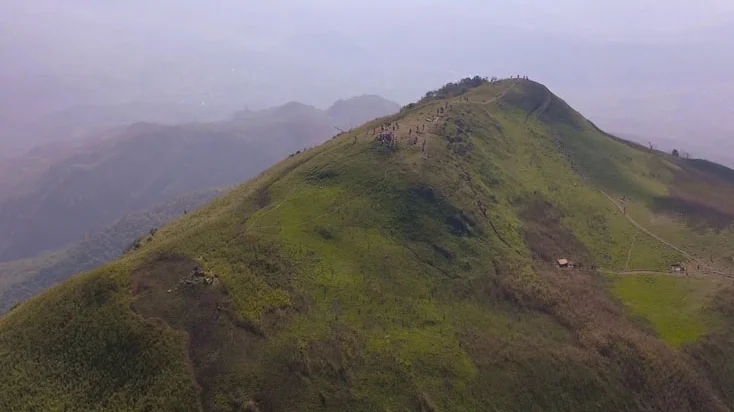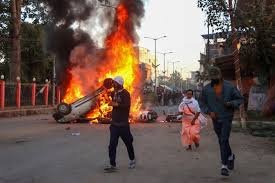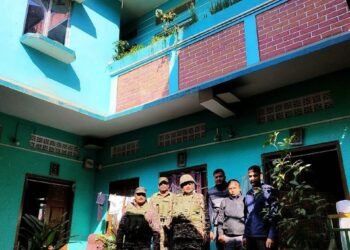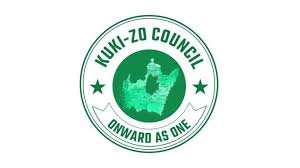Note to Readers:
This article presents the perspectives and arguments from both sides regarding their claims over the Koubru Mountains. Given the sensitive nature of the discourse, which involves religious and cultural beliefs, the intention is solely to inform and foster understanding. There is no attempt to hurt or disrespect anyone’s sentiments.
.BY Navin Upadhyay
April 5, 2005
In recent times, the Koubru Mountains in Manipur have emerged as a focal point of contention between the Meitei and Kuki communities, two ethnic groups whose relations have been strained by ongoing ethnic violence since May 2023. The Committee on Tribal Unity (COTU) Women’s Wing, a prominent voice representing Kuki-Zo interests, has vocally opposed a proposed Meitei pilgrimage to this sacred site, accusing authorities of bias and highlighting deeper issues of territorial rights, cultural identity, and historical claims. This opposition reflects not only the current socio-political tensions but also the complex historical significance of the Koubru Mountains for both communities.
Why the COTU Women’s Wing Opposes the Pilgrimage
The COTU Women’s Wing’s opposition to the Meitei pilgrimage to the Koubru Mountains stems from several intertwined grievances. At its core, the resistance is a reaction to what the Kuki-Zo community perceives as an encroachment on their ancestral lands and a disregard for their cultural and territorial autonomy. The Koubru Mountains, located in the hill districts of Manipur—predominantly inhabited by the Kuki-Zo tribes—hold deep significance for the Kukis, who view the range as part of their historical homeland. The Meitei pilgrimage, supported or facilitated by state authorities, is seen as an attempt to assert dominance over a region where the Kukis have long exercised influence.
ALSO READ: COTU Women’s Wing Slams Manipur Governor for Alleged Bias in Backing Meitei Pilgrimage
The Women’s Wing has reportedly criticized the Manipur Governor and other officials for allegedly favoring the Meitei community in this matter, a charge that resonates with broader Kuki-Zo accusations of systemic bias. Since the outbreak of ethnic violence in 2023, which has claimed over 250 lives and displaced thousands, the Kukis have demanded a separate administration, arguing that their rights and safety cannot be guaranteed under a Meitei-dominated state government. The pilgrimage, in this context, is perceived as a provocative act that undermines their struggle for autonomy and exacerbates tensions in an already volatile region.
Furthermore, the COTU
Manipur Guv’s Pledge to save Koubru, Thangting Hills a prejudice against Kuki-Zo people: COTU Women Wing
https://t.co/JAXOxZKduq— The Hills Journal (@HillsJournal) April 5, 2025
Women’s Wing has framed the pilgrimage as a violation of the fragile status quo. Posts on X and recent news suggest that the Kukis see this move as part of a larger pattern of Meitei expansionism, backed by state machinery, into the hill areas traditionally controlled by tribal communities. The Women’s Wing’s stance aligns with COTU’s broader resistance to initiatives like the Centre’s push for free movement across Manipur, which they argue threatens their security and identity in the face of Meitei influence.
Historical Significance of the Koubru Mountains for the Meiteis
For the Meitei community, who predominantly inhabit the Imphal Valley, the Koubru Mountains hold profound spiritual and cultural importance. Mount Koubru, one of the highest peaks in Manipur, is revered as a sacred abode of Lord Koubru (or Koupalu), a deity in the Meitei traditional religion, Sanamahism. According to Meitei mythology, Koubru is a protector god associated with the northwest direction and is believed to have played a role in the creation and safeguarding of the Meitei people. The mountain is a site of pilgrimage and ritual offerings, symbolizing a connection to their ancestral beliefs that predate the widespread adoption of Hinduism among the Meiteis.
ALSO READ: KOHUR Slams Manipur Govt’s Non-Compliance on NHRC Rights Report
Historically, the Meiteis have viewed the Koubru Mountains as part of their cultural landscape, even though the range lies outside the valley where they are concentrated. This spiritual claim has occasionally led to assertions of access, including pilgrimages, which have gained prominence in recent years as a way to reinforce Meitei identity amid modern ethnic and political challenges. The pilgrimage is not merely a religious act but also a statement of historical continuity and territorial belonging for the Meiteis, who argue that their heritage extends beyond the valley into the hills.
This is Mt. Koubru, the Meiteis’ one of the most sacred mountains. Lord Koubru is synonymous with Meiteis as it is intertwined with the history of Meiteis, ever since the origin of Meiteis.
Till very recently, Koubru was covered with thick forests, rich in flora and fauna. Atop… pic.twitter.com/bTwmEpysWB
— Tribal Koubru (@koubru_lakpa) July 20, 2023
Historical Significance of the Koubru Mountains for the Kukis
For the Kuki-Zo tribes, the Koubru Mountains are equally significant, though their connection is rooted more in territorial and ancestral ties than in a singular religious narrative. The hills of Manipur, including Koubru, have been home to the Kukis for generations, forming part of their traditional lands where they have practiced shifting cultivation (jhum) and maintained their distinct way of life. The mountain range is not only a geographical feature but also a symbol of their identity as hill-dwelling people, distinct from the valley-based Meiteis.
Kuki oral histories and traditions often emphasize their deep bond with the hills, which they see as a refuge and a stronghold against external pressures. While specific religious associations with Koubru may vary among Kuki sub-tribes—many of whom are now Christian due to missionary influence—the mountain’s significance lies in its role as part of their ancestral domain. The Kukis view any Meitei presence in the hills, especially under official sanction, as an intrusion into their space, threatening their autonomy and historical rights.
The Clash of Claims and the Path Forward
The opposition of the COTU Women’s Wing to the Meitei pilgrimage underscores a fundamental clash between two communities with overlapping yet divergent claims to the Koubru Mountains. For the Meiteis, it is a sacred site tied to their spiritual heritage; for the Kukis, it is an integral part of their ancestral territory and a marker of their resistance to Meitei dominance. This conflict is emblematic of the broader ethnic divide in Manipur, where land, identity, and power remain bitterly contested.
ALSO READ: Curfew Imposed in Manipur Villages as Land Dispute Turns Violent
The COTU Women’s Wing’s stance reflects a call for recognition and respect for Kuki-Zo rights in the face of what they see as state-backed Meitei assertions. Their opposition is not just about the pilgrimage itself but about the larger struggle for equity and self-determination in a state fractured by violence. Meanwhile, the Meiteis argue that their religious practices should not be curtailed by territorial disputes, pointing to their historical ties to the mountain.
Resolving this impasse requires more than temporary measures or security interventions. It demands a dialogue that acknowledges the historical significance of the Koubru Mountains to both communities while addressing the underlying issues of trust, representation, and coexistence. As of April 6, 2025, with peace talks between Meitei and Kuki-Zo representatives ongoing yet inconclusive, the Koubru pilgrimage remains a flashpoint—one that encapsulates the challenges of reconciling two proud histories in a shared but divided land.













